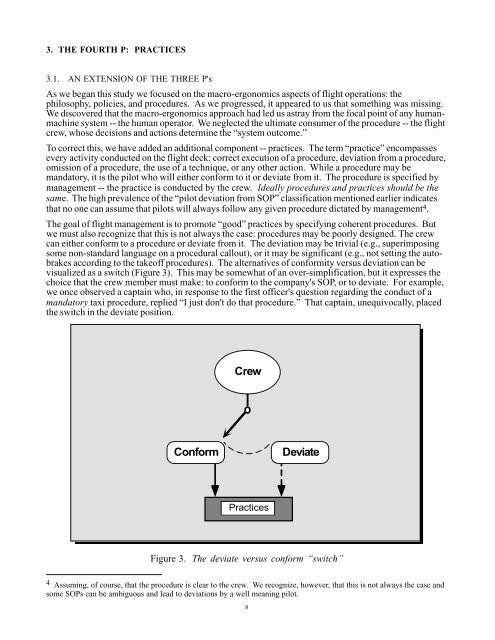On the Design of Flight-Deck Procedures - Intelligent Systems ...
On the Design of Flight-Deck Procedures - Intelligent Systems ...
On the Design of Flight-Deck Procedures - Intelligent Systems ...
Create successful ePaper yourself
Turn your PDF publications into a flip-book with our unique Google optimized e-Paper software.
3. THE FOURTH P: PRACTICES3.1. AN EXTENSION OF THE THREE P'sAs we began this study we focused on <strong>the</strong> macro-ergonomics aspects <strong>of</strong> flight operations: <strong>the</strong>philosophy, policies, and procedures. As we progressed, it appeared to us that something was missing.We discovered that <strong>the</strong> macro-ergonomics approach had led us astray from <strong>the</strong> focal point <strong>of</strong> any humanmachinesystem -- <strong>the</strong> human operator. We neglected <strong>the</strong> ultimate consumer <strong>of</strong> <strong>the</strong> procedure -- <strong>the</strong> flightcrew, whose decisions and actions determine <strong>the</strong> “system outcome.”To correct this, we have added an additional component -- practices. The term “practice” encompassesevery activity conducted on <strong>the</strong> flight deck: correct execution <strong>of</strong> a procedure, deviation from a procedure,omission <strong>of</strong> a procedure, <strong>the</strong> use <strong>of</strong> a technique, or any o<strong>the</strong>r action. While a procedure may bemandatory, it is <strong>the</strong> pilot who will ei<strong>the</strong>r conform to it or deviate from it. The procedure is specified bymanagement -- <strong>the</strong> practice is conducted by <strong>the</strong> crew. Ideally procedures and practices should be <strong>the</strong>same. The high prevalence <strong>of</strong> <strong>the</strong> “pilot deviation from SOP” classification mentioned earlier indicatesthat no one can assume that pilots will always follow any given procedure dictated by management 4 .The goal <strong>of</strong> flight management is to promote “good” practices by specifying coherent procedures. Butwe must also recognize that this is not always <strong>the</strong> case: procedures may be poorly designed. The crewcan ei<strong>the</strong>r conform to a procedure or deviate from it. The deviation may be trivial (e.g., superimposingsome non-standard language on a procedural callout), or it may be significant (e.g., not setting <strong>the</strong> autobrakesaccording to <strong>the</strong> take<strong>of</strong>f procedures). The alternatives <strong>of</strong> conformity versus deviation can bevisualized as a switch (Figure 3). This may be somewhat <strong>of</strong> an over-simplification, but it expresses <strong>the</strong>choice that <strong>the</strong> crew member must make: to conform to <strong>the</strong> company's SOP, or to deviate. For example,we once observed a captain who, in response to <strong>the</strong> first <strong>of</strong>ficer's question regarding <strong>the</strong> conduct <strong>of</strong> amandatory taxi procedure, replied “I just don't do that procedure.” That captain, unequivocally, placed<strong>the</strong> switch in <strong>the</strong> deviate position.CrewConformDeviatePracticesFigure 3. The deviate versus conform “switch”4 Assuming, <strong>of</strong> course, that <strong>the</strong> procedure is clear to <strong>the</strong> crew. We recognize, however, that this is not always <strong>the</strong> case andsome SOPs can be ambiguous and lead to deviations by a well meaning pilot.8
















